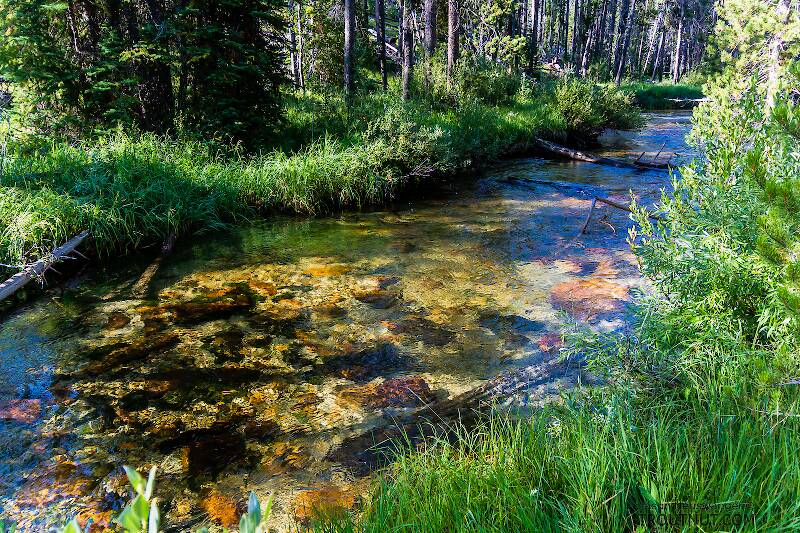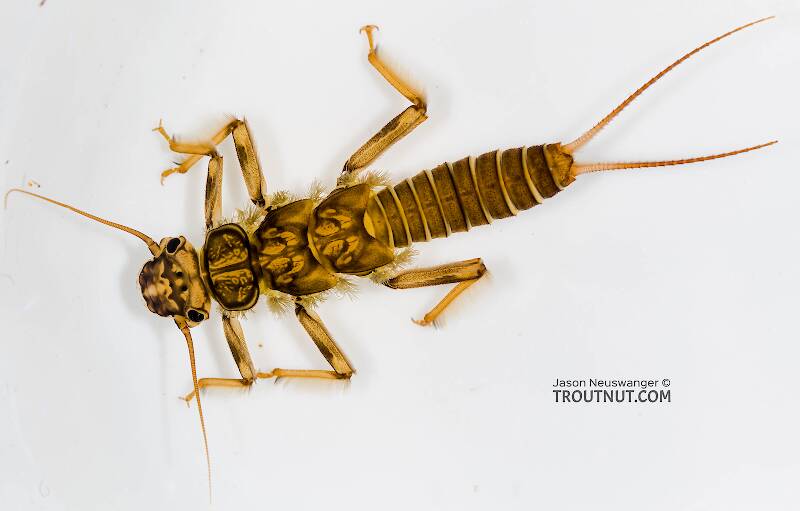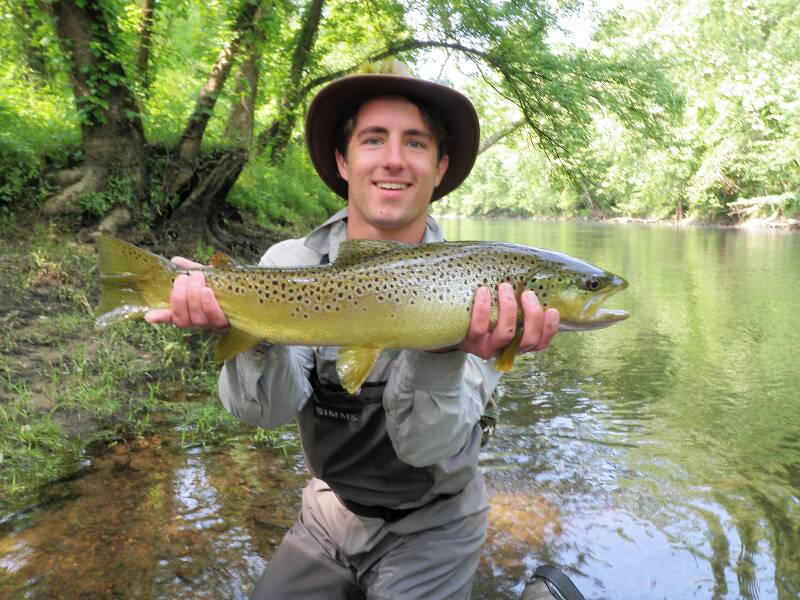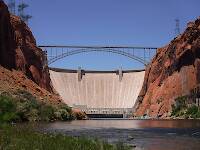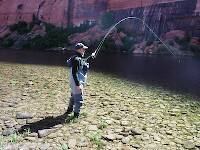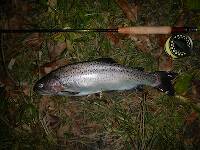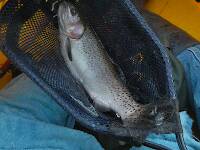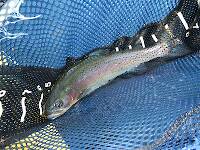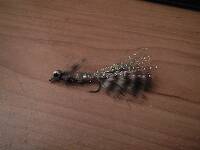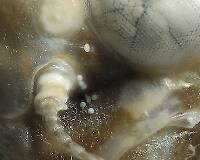
Blue-winged Olives
Baetis
Tiny Baetis mayflies are perhaps the most commonly encountered and imitated by anglers on all American trout streams due to their great abundance, widespread distribution, and trout-friendly emergence habits.
Featured on the forum

Troutnut is a project started in 2003 by salmonid ecologist Jason "Troutnut" Neuswanger to help anglers and
fly tyers unabashedly embrace the entomological side of the sport. Learn more about Troutnut or
support the project for an enhanced experience here.
Jesse on Feb 8, 2012February 8th, 2012, 8:41 am EST
So for some time now i have heard about the positive and negative affects that flooding has on spawning trout. On one side of the spectrum (the negative), i have heard that flooding is bad for spawning fish because it covers their eggs and young with much sedimentation. Preventing a successful spawning process. On the other side of the argument (the positive), i have heard and know that flooding waters allows for easier access of trout to smaller, colder, more appropriate spawning tributaries. Also, it allows for easier access to general movements of trout upstream. Its been said that trout, despite high flows, find the perfect water to spawn in anyway. Its a topic that i often hear about when floods come in, but try to stay open for opinions. What do you guys got?
Most of us fish our whole lives..not knowing its not the fish that we are after.
http://www.filingoflyfishing.com
http://www.filingoflyfishing.com
Entoman on Feb 8, 2012February 8th, 2012, 9:15 am EST
It also cleans the redds of accumulated silt which is good for future spawning.
"It's not that I find fishing so important, it's just that I find all other endeavors of Man equally unimportant... And not nearly as much fun!" Robert Traver, Anatomy of a Fisherman
PaulRoberts on Feb 8, 2012February 8th, 2012, 9:22 am EST
It's not an either/or. All the above, and lots more, can be true. Nature doesn't hold back for no one -whether it has scales, feathers, fur, or... neoprene.
Redds are attempted in a range of locations and conditions that surround an "optimum". Those that survive pass it on. Those that don't, don't. And it's not always their fault. In this way populations adjust over time to a range of conditions. Some years virtually entire spawns can fail. Others years it's a boon.
Redds are attempted in a range of locations and conditions that surround an "optimum". Those that survive pass it on. Those that don't, don't. And it's not always their fault. In this way populations adjust over time to a range of conditions. Some years virtually entire spawns can fail. Others years it's a boon.
Falsifly on Feb 8, 2012February 8th, 2012, 11:28 am EST
Unless I’m mistaken trout predate our existence and have endured eons of flooding and drought, not to mention extreme global environmental changes. To view natural occurrences as positive or negative is nothing more than an anthropomorphic presumption caught in the myopia of the here and now. Through the eyes of the fisherman it’s a question of how is it going to effect my fishing tomorrow. In the grand scheme of things it is what it is, has always been, and always will be….. ;)
Hey, you asked.
Hey, you asked.
Falsifly
When asked what I just caught that monster on I showed him. He put on his magnifiers and said, "I can't believe they can see that."
When asked what I just caught that monster on I showed him. He put on his magnifiers and said, "I can't believe they can see that."
PaulRoberts on Feb 8, 2012February 8th, 2012, 11:37 am EST
Mmmmmmmm...no, things have changed drastically. Flooding and drought are much more frequent and intense due to watershed disturbances by human development. This is old news. Widen the scale and we are actually living within a global extinction rate that rivals those in the distant past that literally define the boundaries of major geologic periods.
Oldredbarn on Feb 9, 2012February 9th, 2012, 4:46 am EST
Allan & Paul...I have yet to have my second cup of tea and find myself this morning still wearing my rose-colored glasses...Go figure? I must of exited the bed on the correct side for a change...I'll get back with you here...
On the not so natural side of it though we have had some problems below some of our dams here with spring spawning smallie's because the despot controlling the lever doesn't want the folk in the man-made lake above the dam ever to have to step up or down an inch to get in to their pontoon party boats...
Spence
On the not so natural side of it though we have had some problems below some of our dams here with spring spawning smallie's because the despot controlling the lever doesn't want the folk in the man-made lake above the dam ever to have to step up or down an inch to get in to their pontoon party boats...
Spence
"Even when my best efforts fail it's a satisfying challenge, and that, after all, is the essence of fly fishing." -Chauncy Lively
"Envy not the man who lives beside the river, but the man the river flows through." Joseph T Heywood
"Envy not the man who lives beside the river, but the man the river flows through." Joseph T Heywood
Jesse on Feb 10, 2012February 10th, 2012, 10:53 am EST
Good points by all and i understand the adaptation of trout to deal with natures elements. I was more or less wondering on a year to year basis, but i guess is that its neither good nor bad, but a little bit of both.
Most of us fish our whole lives..not knowing its not the fish that we are after.
http://www.filingoflyfishing.com
http://www.filingoflyfishing.com
PaulRoberts on Feb 10, 2012February 10th, 2012, 11:14 am EST
Lots of potential effects, Jesse. Minor flooding/spates are what do the work in streams, creating pools, pockets, etc... -"digging spates" I call them. But I've seen "catastrophic floods" make barren moonscapes out of previously awesome stretches, only to have them re-dug back into trout hotels in subsequent years.
Because of ditching and draining (everywhere a development goes in), many streams are more prone to be "flashy" as water is removed from the surrounding land at a quicker rate, rather than being retained in the land. Habitat too becomes "flashy" -here today, gone tomorrow. Fish populations may adapt, but some level of stability in the system sure helps grow trout.
As you mentioned, flow affects spawning too. Many trout rely on seasonal spates to move into spawning/nursery stretches. But big floods can scour eggs and sweep fry out of nursery water. Each year is different, and you can see where some stability here is made good use of.
In waters with stable flow, trout lead much more stable lives, often living in small home ranges -some even spending their summers in one pool. In flashier streams, trout move like crazy. Summer, fall, and winter create different habitat needs and trout find these, or perish. Trout in many waters may treat an entire watershed like they might a lake -this seems esp so with those big browns.
Individual trout handle high water pretty darn well. And aquatic insects are mobile and fecund and can rebound quickly even after catastrophic floods. One year, we had a nasty flood while I was teaching a FF course. When we went to sample for inverts in a diverse stream (I'd sampled successfully just the previous week), we caught NOTHING! It was scoured clean. So, we had a nice streamside chat about floods, and rescheduled.
Oh...I also wrote an article on high water fishing strategies called "Ain't No River High Enough" in the March/April 2002 American Angler.
Because of ditching and draining (everywhere a development goes in), many streams are more prone to be "flashy" as water is removed from the surrounding land at a quicker rate, rather than being retained in the land. Habitat too becomes "flashy" -here today, gone tomorrow. Fish populations may adapt, but some level of stability in the system sure helps grow trout.
As you mentioned, flow affects spawning too. Many trout rely on seasonal spates to move into spawning/nursery stretches. But big floods can scour eggs and sweep fry out of nursery water. Each year is different, and you can see where some stability here is made good use of.
In waters with stable flow, trout lead much more stable lives, often living in small home ranges -some even spending their summers in one pool. In flashier streams, trout move like crazy. Summer, fall, and winter create different habitat needs and trout find these, or perish. Trout in many waters may treat an entire watershed like they might a lake -this seems esp so with those big browns.
Individual trout handle high water pretty darn well. And aquatic insects are mobile and fecund and can rebound quickly even after catastrophic floods. One year, we had a nasty flood while I was teaching a FF course. When we went to sample for inverts in a diverse stream (I'd sampled successfully just the previous week), we caught NOTHING! It was scoured clean. So, we had a nice streamside chat about floods, and rescheduled.
Oh...I also wrote an article on high water fishing strategies called "Ain't No River High Enough" in the March/April 2002 American Angler.
Jesse on Feb 14, 2012February 14th, 2012, 9:05 pm EST
Do you by any chance have a copy of that article Paul?
Most of us fish our whole lives..not knowing its not the fish that we are after.
http://www.filingoflyfishing.com
http://www.filingoflyfishing.com
Quick Reply
Related Discussions
Topic
Replies
Last Reply
Re: First trout fishing in my new home - not a major success, but a minor one!
In Fishing Reports by Jmd123
In Fishing Reports by Jmd123
3
Jun 14, 2011
by Drew
by Drew
2
Nov 22, 2016
by PaulRoberts
by PaulRoberts

